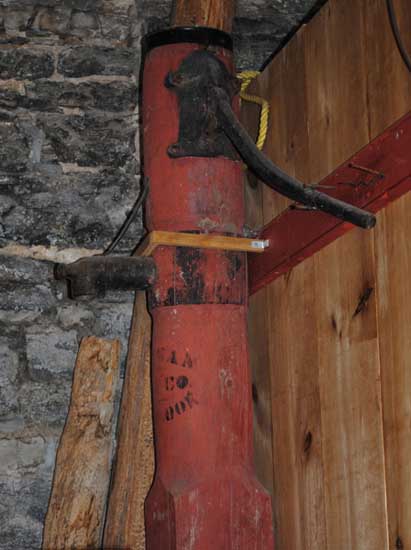
The Horse & Buggy Era (1880-1900)Wartman's Pumps |
|||
|
|||
Wooden pump from the Wartman Pump Company, Colebrook |
By 1851, Charles Wartman, son of Peter and Rhoda Wartman, Kingston Township, moved to Colebrook, Camden East Township. On the 1871 Census, he is listed as a "Mechanic," likely working as a machinist in a nearby mill. DISCOVER MORE![]()
In 1877, Colebrook experienced a massive fire that destroyed several buildings, including a saw mill on the north side of the river. After this disastrous fire, Charles Wartman bought this lot to harness the available waterpower. He erected a large thirty by forty foot building that included a basement. By 1879, Charles started a business hand crafting wooden pumps to be used on farms for wells up to twenty feet deep. A large turning lathe was installed in the basement of his shop, on which hundreds of pumps were turned.
The pump making process began by squaring freshly sawn pine logs, which were then rafted together and sunk for a period of at least four years. This prevented the wood from splitting when it was turned. After the logs were properly soaked, they were removed from the river by a power windlass, and sent to the mechanic. A c1950 photograph shows the Wartman Pump Company's log pond. The logs were placed on a revolving lathe and shaped by the mechanic using turning chisels, while a second man would hold different length augers against a guide rod. During the shaping, a hole was bored through the length of the log. A handle and metal spout, made by the Connoly Manufacturing Company of Yarker, were added.
The pump worked by using simple wood or lead cylinders, measuring approximately sixteen inches long by four inches in diameter, to plunge and pump water up from the ground. Every spring, in the span of a few days, an entire year's supply of cylinders was produced by hanging a kettle of lead over a large fire by the roadside, and pouring the lead into mouldings. A hand crank auger was used to enlarge the hole through the middle of the pump wide enough to insert the cylinders.
Wartman pumps were well received, and earned a reputation for raising the most water with the least labour. Finished pumps were loaded onto wagons and sold in Napanee and Kingston every Saturday. Pumps often included the Wartman Pump Company's logo stenciled on the front.
Frank and Wilbert Wartman, sons of Charles and his first wife Elizabeth, joined their father in the family trade. Their entry in the 1889 Business Directory reads, "Wartman Bros (Wilbert F and Frank), planning mill, lumber and agrl [agricultural] implements." Their father's entry reads, "Wartman, Charles H, pump maker." After Charles' death in 1890, his sons took over the business entirely, with Frank managing the manufacturing of the pumps and their sale west of the Moscow-Colebrook road, and Wilbur managing the sale of the pumps in the district to the east. By 1915, Frank sold the business to Norman Boyce and Ira Salsbury. The last pump was produced in 1959.
© Lennox & Addington County Museum & Archives
97 Thomas Street East, Napanee, Ontario, Canada K7R 4B9
Funding provided by the Government of Ontario and the County of Lennox & Addington




